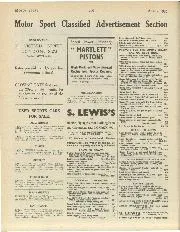
LEATHER HELMETS FOR SPORTS CARS
LEATHER HELMETS FOR SPORTS OARS. Leather Helmets, perfect fitting, super quality, in black, brown, green, blue or white, for ladies or gents ... 8/6 Helmets in waterproof Grenfell material, In…
gAQ
V recent years there has developed a marked tendency in some quarters to exaggerated speed claims in endeavours to get increased sales. Such claims would never be substantiated if every buyer demanded that the performance should be accurately checked, but obviously such a course is in most cases impossible. This has given unscrupulous manufacturers an opportunity, which they have quickly taken, of playing on the vanity of the average owner. The speedometer, instead of being used as the accurate scientific instrument on which its designers and makers are to be congratulated, has been turned into the means of substantiating the speed claims of manufac of the car manufacturer. At first the intentional error was small, but just enough to demonstrate to prospective buyers that the car was faster than a rival make. Then the idea spread. Other makes, in self-defence, made similar changes and speeds apparently increased all round. From the sales point of view the dodge was highly successful, due in the main to the buyers themselves. Firstly, most people are slow to admit that they have been “stung,” and so uphold the claims of their instruments. Secondly many are boastful and like to ease their consciences by
laying the responsibility for their boasts at the makers’ door. Thirdly, a number of people actually believe their optimistic speedometers, some because they want to, and some because they do not know any better. The result has been the quite common, though not quite universal, practice of fitting speedometers with
an error of about 5 per cent. or so. A few sports car makers refuse to follow suit, and still fit accurate instruments, to their lasting credit. Others excuse themselves by the plea of self defence. The real culprits, however, are not only those who originated the practice, but who are to-day trying to outdo their rivals by start
ing new standards of exaggeration. MOTOR SPORT recently tested the speedometer of
a new sports car straight from the showroom, and found it had an error of no less than 20 per cent. We consider that anyone who purchased such a car as a result of a demonstra tion run would have excellent grounds for bringing an
action against its maker for deliberate misrepresentation.
Such practice is no help to business, and we hope our readers will do their best to expose offenders, and so help to put down this thoroughly dishonest practice.